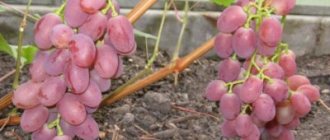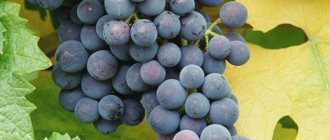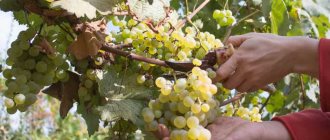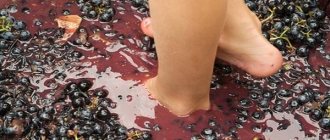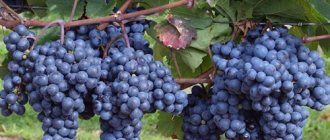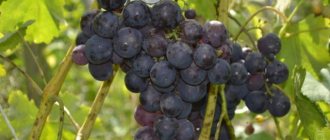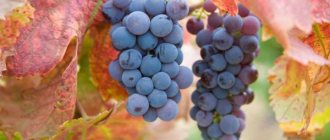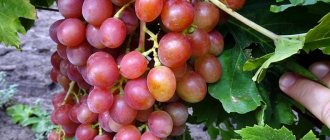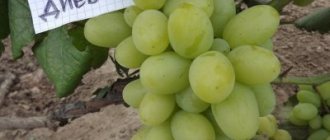Advantages and disadvantages
Pros:
- Early ripening.
- Unusual taste.
- High frost resistance.
- Possibility of brushes remaining on the bush for a long time without losing their taste characteristics.
- Easy to care for.
- Good yield.
- Resistance to major grape diseases.
Minuses:
- Tendency to cracking.
- Susceptibility to attacks by wasps.
- Relatively light brush weight.
Easy to grow and excellent in taste - Russian Early grapes
Less than a quarter of a century ago, grapes were considered an exotic crop. But now viticulture has risen to a new level. Now anyone can plant a grape bush on their plot.
But the problem always arises: which variety to choose? After all, each of them differs from the other not only in taste, but also in many other factors.
In this article we will describe all the characteristics of the Russian Early grape.
Main characteristics
“Russian Early” is an early variety with very tasty caramel fruits, prone to cracking, but no less attractive to the buyer. Well-selling varieties also include varieties “Arcadia”, “Moldova” and “Preobrazonie”.
Ripening period
From the moment the buds open until the grapes ripen, about 110–115 days pass. The first harvest usually begins to be harvested in late July - early August, which means that the variety can be considered very early in terms of ripening.
Bush
The “Russian early” bush is considered medium-sized, but it is characterized by active growth in breadth: one bush can stretch 5 meters.
The leaves are large, three-lobed, although they also have five lobes, and resemble a heart in appearance. They are painted in a rich green color, and the back side of each leaf blade is covered with light-colored bristly pubescence. The flowers are bisexual, as a result of which the variety does not require additional pollination.
Bunches and berries
The clusters are small, very loose. Their average size is 20–25 cm, weight is 200–400 grams.
Important! The size of the brushes can be somewhat enlarged by rationing the harvest: no more than 2 inflorescences should remain on one shoot.
Unusually large bunch of “Russian early”
Oval berries of “Russian early” medium size: 6 – 7 g and 21 – 23 mm in diameter. The dark pink skin is thin and breaks easily when bitten. The pulp is dense, fleshy, but at the same time juicy. Each grape contains 3 fairly large seeds, which somewhat spoils the pleasure of eating the fruit. The berries accumulate sugar well (17–21%), while having a pleasant sourness (6–7 g/l).
Reference! The skin of the berries is very thin and with a lack of moisture or its excess easily cracks, thereby attracting insects.
Taste and yield
This variety received its second name – “candy” – due to the pleasant aroma and taste of berries, vaguely reminiscent of caramel.
An adult bush is able to produce up to 25 kg of appetizing and juicy fruits, a young plant – up to 7 kg.
Comparison with analogues
“Russian Early” is one of the popular very early varieties of pink grapes. Compared to other similar varieties, it looks advantageous in the positions “Yield”, “Taste”, “Disease Resistance”, which is confirmed by the table below.
| Sign | Variety | |||
| Russian early | Sofia | Kostrikin's anniversary | In memory of the teacher | |
| Ripening period | 110 – 115 days | 110 – 115 days | 100 – 115 days | 100 -110 days |
| Frost resistance | -23C | -21C | -24С | -23C |
| Productivity | Up to 25 kg | Up to 10 kg | Up to 15 kg | 10 – 20 kg |
| Bunches | 200 – 400 g | 1 – 3 kg | 400 – 500 g | 600 g – 2.5 kg |
| Taste | Notes of caramel | Muscat | Taste of honey | Harmonious with notes of nutmeg |
| Color | Dark pink | Pink | Dark pink | Pink cherry |
| Disease resistance | Above average | average | Above average | Average |
| Shelf life | 1 month | 2 months | 1 – 2 months | 3 months |
| Sugar accumulation | 17 – 21% | 17 – 19% | 18 – 20% | 18 – 20% |
| Acidity | 6 – 7 g/l | 6 – 7 g/l | 6 – 7 g/l | 6 – 8 g/l |
Origin
Breeders - employees of the Ya.I. Potapenko All-Russian Research Institute of Viticulture, as a result of crossing the Chasselas northern and Michurinets grape varieties, developed a new hybrid, "Russian Early", which is also known under another name - "sweetie". The new variety turned out to be resistant to low temperatures and fungal infections, which made it one of the most popular and desirable in domestic vineyards.
The parents of the “Early Russian” are “Shasla Severnaya” and “Michurinets”
Useful properties and applications
Grape seed extract restores the activity of blood vessels and strengthens them
100 g of “Russian early” grapes contains about 65 kcal, and its glycemic index is 45 units, which allows it to be consumed in reasonable quantities even by people with diabetes.
The range of positive effects of pink berries on the human body is extremely diverse:
- Strengthening properties. The rich set of vitamins and microelements in the composition help strengthen the human immune system and strengthen its ability to resist infectious diseases.
- Expectorant effect. Pink grapes are ideal for diseases of the respiratory system, as they facilitate the removal of phlegm.
- Rejuvenating effect. Antioxidants and vitamins in berries have a beneficial effect on the skin of the face and body, making it elastic and more toned, as well as on nails, hair and vision.
- Anti-inflammatory property. The active substances of grapes, entering the human body, begin to fight inflammation, gradually extinguishing them.
- Exchange effect. Pink grapes help boost metabolism and in small quantities will be very useful even for those trying to lose weight.
“Russian Early” is recommended for fresh consumption, as well as as an ingredient in culinary delicacies. Sometimes the berries are used as raw material for the production of juice and wine.
Features of cultivation
The “Russian Early” variety is ideal for planting in the central regions and is considered a frost-resistant and unpretentious variety, which has an average presentation and has a very short shelf life.
Boarding time
“Russian early” seedlings can be planted in autumn and spring, but experienced winegrowers advise doing this at the end of the season. Overwintering young plants in the ground allows them to quickly adapt to new conditions and harden themselves properly: in the future, such bushes will be strong, resistant to adverse environmental conditions and infectious diseases.
With the onset of spring, they will immediately begin to grow. When planting in autumn, the main thing is to do it before the first frost, or rather, 2 to 3 weeks before it. This time will be enough for the young plant to acclimatize.
Place and soil
Grapes, no matter how frost-resistant they may be, are still a southern plant, so to plant them in your garden plot you should choose a place protected from drafts, which is heated by the sun during the day. It is advisable to plant “Russian early” on the southern side of the buildings, but it is important to ensure that tall trees that can shade the vineyard do not grow nearby. In addition to protection from the wind, the wall of the building at night will transfer the heat accumulated during the day to the bushes, thereby having a beneficial effect on the development of the vine.
Attention! Twice a season, the soil under the bush should be thoroughly loosened, all weeds should be removed, and the surface of the soil should be covered with mulch - peat, sawdust or humus.
“Russian Early” grows quickly, so when planting several bushes of this variety nearby, you should maintain a distance of 3 meters between them. The depth of the hole must be at least 70 cm. Its bottom must be covered with a layer of drainage, since the variety is sensitive to stagnation of moisture. It’s good if the soil on the site is fertile and loose, otherwise it needs to be enriched and made porous. This can be done by adding river sand (1/2 bucket), wood ash (500 g), and a mixture of humus (1:2) to the soil dug out of the hole.
Watering and fertilizing
Watering is an integral element of grape care. “Russian early” loves moisture, but does not tolerate stagnation of moisture in its roots, so the bush needs to be watered, but strictly according to the schedule.
- In early spring and late autumn, so-called moisture-charging irrigation is required. At the beginning of the season, it “fills” the grapes with juices, and at the end it helps the plant survive the cold winter.
- After flowering and when the berries begin to ripen, 2 more mandatory waterings are carried out.
- The following are in case of dry and hot weather. If precipitation falls systematically in summer, then you should limit yourself to the watering listed above.
Important! The water consumption rate for watering one bush is 10 - 20 liters.
There can be no talk of any rich harvest if the plant is not fertilized . Fertilizers are usually applied during watering and are carried out according to a certain scheme:
- In spring - nitrogen-containing or complex mineral fertilizers.
- When fruits begin to ripen, fertilize with potassium and phosphorus.
- In the fall, before sheltering for the winter, a complex mineral composition. Once every 2–3 years at the end of the season, organic matter should be added, but not more often, otherwise the fruits may begin to taste bitter.
Trimming
A rapidly growing plant requires annual pruning, the quality of which determines the yield and presentation of the fruit.
With the establishment of constant heat, but even before the start of sap flow, frozen and damaged vines are removed. During flowering, the yield is rationed: weak, defective brushes are removed. In autumn, the formation of a bush is carried out, starting from the second year of the plant’s life. It is possible to perform both short and medium pruning, during which 2 to 3 buds remain on each shoot.
Diseases and pests
“Russian Early” has good resistance to mildew, oidium, and all types of rot.
However, the variety has weak immunity to powdery mildew and phylloxera, and without preventive measures the plant may die within a few years. The set of necessary measures that will prevent the plant from being damaged by disease and pests should include:
- Sanitary pruning in autumn and spring with the destruction of affected shoots.
- Treatment with copper sulfate 2 times a year (10 g of powder per 10 liters of water).
- Irrigation during flowering with ash or soda.
- Growing parsley next to a vineyard.
- Be careful when watering to avoid moisture getting on the leaves of the plant.
- Treatment of bushes affected by phylloxera with insecticides Fozalon, Actellik, Fastak; A sulfur solution (100 g per 10 liters of water) will help deal with powdery mildew.
The real attack on the “early Russian” is wasps. The methods of dealing with them are simple but effective: smoke bombs, destruction of wasp nests, sweet baits with poison, special bags placed on the grapes.
Wintering
The “Russian Early” variety is characterized by high frost resistance – minus 23ºС. The crop does not need shelter if the thermometer never drops to such levels during the winter. If this does happen, even in isolated cases, then it is better to play it safe and insulate the plant.
After autumn feeding and moisture-recharging watering, the lashes are removed from the support, bent to the ground, and tied together. It is recommended to lay spruce branches under them, and on top - a covering material, for example, agrofibre and a layer of earth.
Attention! For a safe winter, it is recommended that the plant undergo a kind of hardening: the bush should spend the first frosts in an uninsulated state.
Harvest storage
Juicy berries with thin skins are not capable of long-term storage, so it is advisable to eat them immediately or send them for processing. If the required temperatures for successful storage are observed (0ºС – +5ºС), the fruits can last for about a month.
Cultivation regions
The best harvest of “Russian early” grapes can be obtained in the central part of Russia and Ukraine. Its frost resistance and short ripening period contribute to its spread to the northern regions: Siberia, the Urals, Karelia.
Grapes for different regions
When choosing a grape variety, special attention should be paid to its suitability to the climate of a particular region.
Krasnodar region and Crimea
The natural conditions of southern Russia, especially Crimea and the Krasnodar Territory, are ideal for growing grapes. Almost all varieties of this heat-loving crop grow and bear fruit here. High-yielding varieties with tasty and large fruits are especially popular among local residents:
- Cardinal;
- Hamburg Muscat;
- Moldova;
- Sabbat;
- Kishmish radiata;
- Biruinets;
- In memory of the Surgeon;
- Anyuta.
There are many wineries on the Crimean Peninsula and in the Krasnodar Territory, so technical grape varieties are in high demand:
- Muscat pink;
- Cabernet Sauvignon;
- Aligote;
- Chardonnay;
- Traminer pink.
Crimea is an excellent place for growing grapes
Donbass
The long hot summer of Donbass allows many grape varieties to ripen. But they can suffer during fairly cold winters with little snow. Winegrowers in this region prefer relatively frost-resistant varieties. These include:
- Agat Donskoy;
- Codrianka;
- Liana;
- Pukhlyakovsky;
- Laura;
- Mascot;
- Galahard;
- Long awaited.
Middle Volga region, including Samara region and Tatarstan
In recent years, grapes are increasingly found on the household plots of residents of the Middle Volga region. A great contribution to the development of viticulture in this region was made by specialists from the Samara Zonal Experimental Fruit and Berry Station, who created many new varieties adapted to the local climate. Among them:
- Kuibyshev's firstborn;
- Kuibyshevsky early;
- Beauty of the Volga region;
- Crane;
- Kuibyshev Muscat.
In the Samara region and Tatarstan, unpretentious or complexly resistant varieties also perform well:
- Kesha;
- Pleven is resistant;
- Agat Donskoy;
- Codrianka;
- Lydia.
Central Russia and Moscow region
In central Russia and the Moscow region, grapes often suffer from frosty winters and insufficiently warm summers. Return frosts, which often occur during the flowering period of the crop, also have a detrimental effect on it.
To get a guaranteed harvest, winegrowers in the middle zone and the Moscow region grow only early frost-resistant varieties. Among them:
- Alyoshenkin's gift;
- Russian Korinka;
- Delight;
- Liana;
- Beauty of the North;
- Crystal;
- In memory of Dombkowska;
- Muscat Moscow.
Video: grape harvest on a farm near Moscow
North-West of the Russian Federation and Belarus
The North-West of the Russian Federation and the Republic of Belarus are characterized by short, rather cool summers with a lot of precipitation and a lack of sunny days. Not every grape variety can ripen and accumulate a sufficient amount of sugar in such conditions. In addition, wet weather increases the risk of developing various fungal diseases.
In such difficult climatic conditions, most winegrowers choose modern varieties that are resistant to diseases and low temperatures:
- Muromets;
- Alyoshenkin's gift;
- In memory of Dombkowska;
- Victor;
- Galahard;
- White miracle;
- Delight.
In Siberia
In Siberia, the main risk factor for grapes is extremely cold winter temperatures. But breeders have created varieties that grow and bear fruit even in such difficult conditions. Among them:
- Sharov's riddle;
- Taiga emerald;
- Tukay;
- Alpha;
- Cheryomushka Siberian,
- In memory of Dombkowska.
Video: vineyard in Siberia
Thanks to the tireless work of breeders, winegrowers have a large selection of varieties of their favorite crop. Each of them can choose grapes for their plot that most fully meet all their requirements.
Reviews
The taste of Russian early is very pleasant, full, harmonious, high-sugar. Alexander, Kiev region, Balaya Church
I have been growing it for over 20 years. Until now, without any chemical treatments, it bears fruit perfectly without covering. Growth vigor is above average, overloaded with harvest. Alexey Ananyevich, Vinnitsa region.
